Camp Life at the American Canoe Association
by: Lynn E. McElfresh
For many a summer the American Canoe Association made quite a splash in the Thousand Islands, during its early years. Besides the influx of hundreds of canoeists, the ACA rendezvous attracted a following of onlookers. Typically slated for the first two weeks in August, newspaper advertisements started appearing in early February with inducements such as: “excursions in full view of the canoe camp” and “Insure a seat! Book early!” While the events attracted spectators, the camp itself was a curiosity, as interesting as a circus or Wild West show. Excursions to view the camp from the water ran day and night.
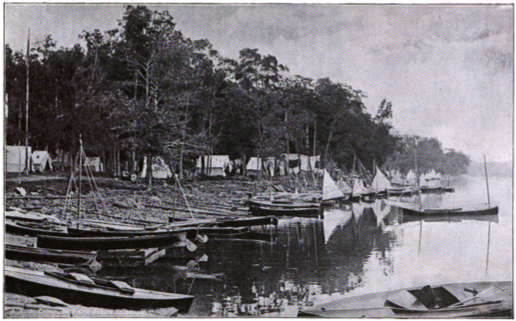
The Average Canoeist
Reading through the newspaper accounts, it seems a wide range of canoeists attended the ACA rendezvous. Some newspapers reported that the ACA members were from the well to do set, who arrived with valets, elaborate camp gear, and caterers. One dandy even arrived with a portable bathtub! Still, a few canoeists merely pulled their canoes ashore, rigged a little tent over the cockpit, and slept comfortably in that way.
Many of the attendees were bachelors. The Thousand Islands’ summer girls looked forward to this annual influx of the young, handsome, athletic canoeists. The Knoxville Journal described these bachelors as “dudes.” Apparently, they enjoyed this attention from the “fairer sex.” According to the paper, “While the simple-minded fellows are off fishing, reading, racing, or cruising, the “dudes” in spotless uniforms, newly varnished canoes, all polished nickel fittings, and new sails with eccentric figures painted on them, will skim off toward the hotel and create a sensation by lunching and spending part of the day there in the society of girls.”
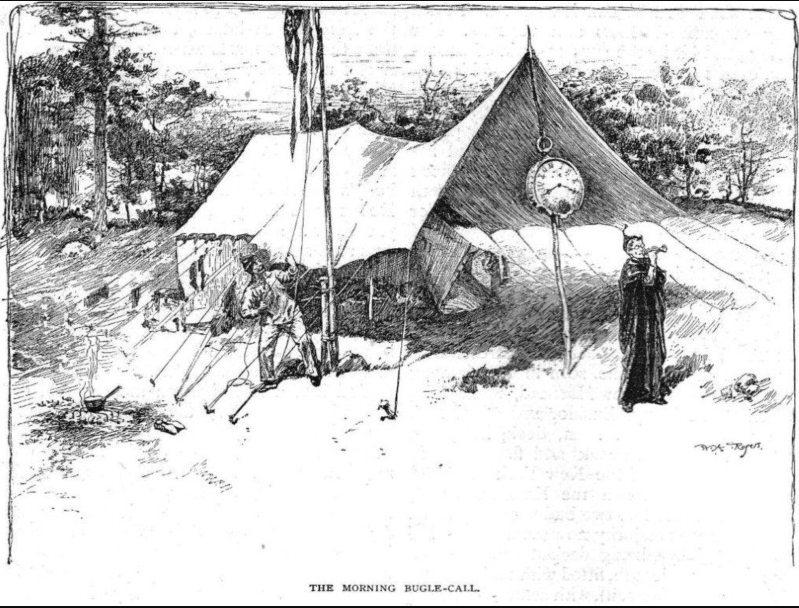
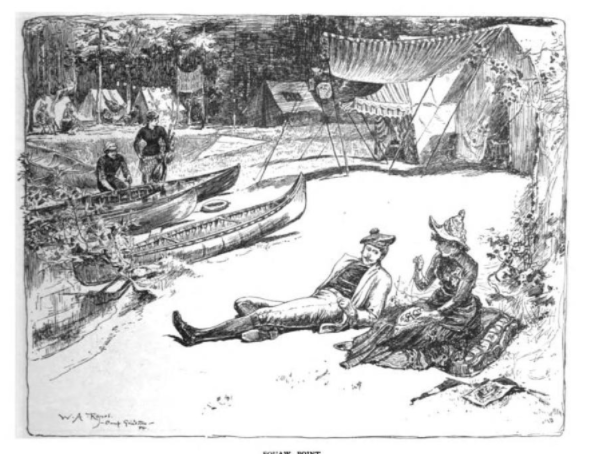
Canoeists Costumes
The 1886 Brooklyn Daily Eagle reported that “the typical canoeist’s costume consists of a Norfolk jacket or blouse, a light felt hat, canvas shoes, and a gray or dark blue shirt. All their clothing is unshrinkable. Many prefer knickerbockers as being cooler and more convenient, in case wading is to be done.” Some ACA campers only brought old clothes to the rendezvous and could care little whether they capsized or not. Others were more concerned about their appearance. According the Knoxville Journal, “others bloom out every day in some new and striking blazer, scarf or uniform.”
Some clubs distinguished themselves with matching outfits. The Mohican Club of Albany was distinguished by large gray felt hats with metal medallions stamped with the totem of their lodge prominently attached. Ottawa Club members were decked out in their national red and white colors.
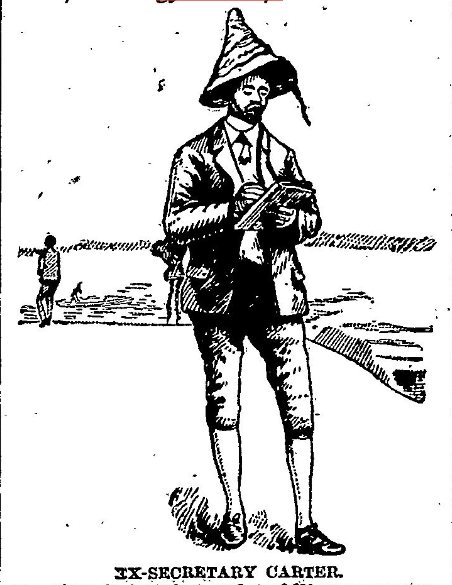
The ACA Camp By Day
On an ordinary canoe outing, everything for the trip had to fit inside the canoe. Whatever the canoeist brought with him for the trip — his canoe and his baggage — he had to carry himself. However, when attending the ACA rendezvous, attendees’ canoes and baggage were shipped via rail to the River, loaded on a small steamer, and transported to the camp. Therefore, the canoeist could provide himself with all sorts of comforts for his two-week stay. Far from primitive, the ACA camp provided canoeists a way to rusticate in style. Quite a few tents had raised board floors and the interiors decked out with cots and easy chairs. Today, we’d call this “glamping.”

The start of the camp must have caused quite a flurry. According to Daily on the St. Lawrence in 1893, “tents, trunks, and bedding are piled high on the dock faster than they can be carried away to be utilized by the campers.”
Once assembled, the ACA camp was quite a sight. Hundreds of white tents – big and small – dotted the campground. Each canoe club had a headquarters tent marked by a tall pole from which flew the club’s flag. Featured on the flag was the club’s “totem”— usually an animal. There were at least a dozen or more club tents with colorful pendant flags flapping in the river breeze. Individual club members’ tents clustered around the main club tent.
Club tents were sometimes lavishly appointed. Daily on the St. Lawrence described the Lowell Canoe Club tent as “one the nattiest little retreats on the grounds.” Like many club and individual tents, this retreat had a name. It was called “Midway Plaisance” after the famous Chicago Midway, hinting that their tent might feature entertainment reminiscent of the original Midway, such as comedic actors or exotic Egyptian dancers.

While the tents were mostly white, they were decorated with flags, pendants, and buntings. The flagpole in front of the headquarters flew the ACA flag lavishly embroidered with “Entente Cordiale,” the ACA motto, meaning “a friendly alliance”.
Perhaps the most popular flag was a solid red flag. When hoisted outside the large dining tent, the flag announced that a meal was ready to be served. At the early rendezvous, canoeists brought their own provisions and cooked their own meals on small fires in front of their tents. But as the rendezvous grew in popularity, a kitchen was constructed near the dining tent, which could seat 250 canoeists.
Some clubs hired caterers and served meals in the club tent. Sometimes, the canoeists enjoyed the bounty of the St. Lawrence. Daily on the St. Lawrence reported that a Mr. Muckleston caught a twelve-pound muskellunge, which the Mohican Club celebrated by making it into a chowder for their members.
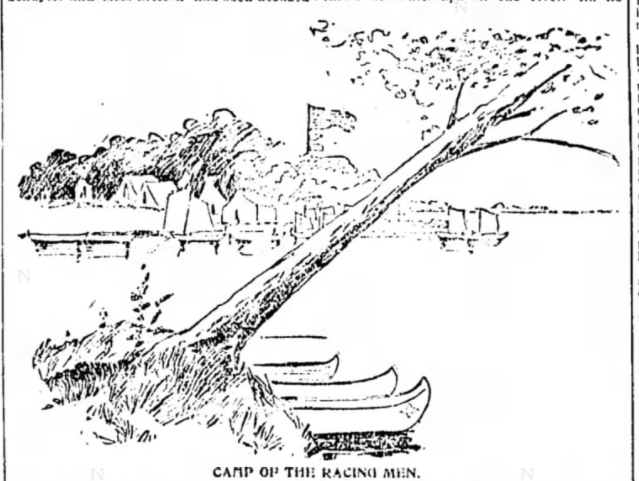
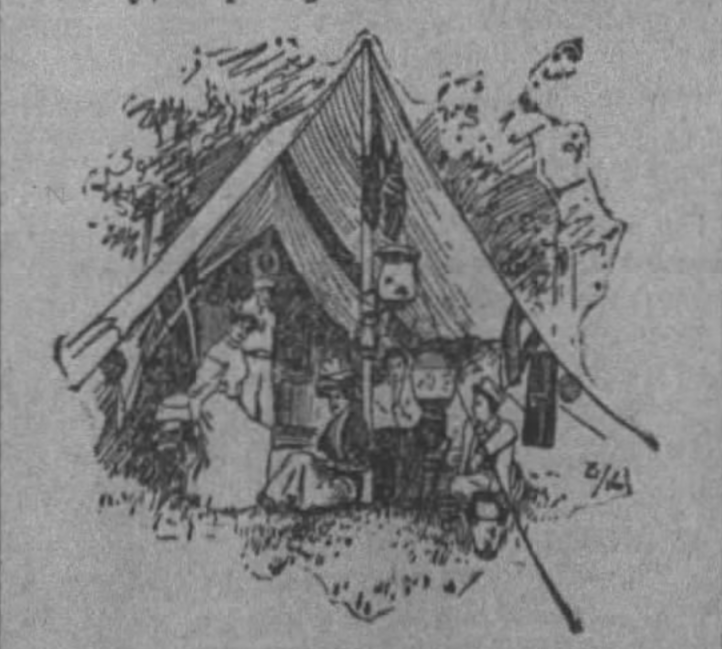
Daily Camp Life
The first week of camp was for fishing, taking paddling excursions, setting up the racing course, and socializing. The Knoxville Journal described it as a week of continuous “jollification.” Although not professional sportsmen, the men gathered here were enthusiasts who loved not only the sport of canoeing, but also being in the company of others who loved the great outdoors as much as they did.
Despite having festivities late into the night, in general, the campers were early risers, up and active by six. The ACA had a schedule and rules. Colors were raised at the main flagpole at 8 am; at sunset, they were lowered again, accompanied by a bugle playing taps.
The races were always planned for the second week of the meet. During that time, the canoeist stuck close to camp, either as competitors, judges, or spectators of the competition.
In many ways, the campground was a mini-city. In addition to the dining tent, by the 1890s, the camp also had a surgeon who had a fully equipped pharmacy. Many of the canoeists were photography enthusiasts, so a dark room was built to develop their photographs. On Sundays, an Episcopal service was held on the campgrounds. It seems the ACA committee thought of everything.
Squaw Point
No matter where the camp was held, there was a special section reserved for the ladies, referred to as Squaw Camp or Squaw Point*. As the rendezvous grew in popularity, so did the size of the ladies’ camp area!
I found the following quotation from an 1894 New York Times article most interesting: “Some of the older members recall the early days of the association, when every member paddled to the camp, put up his own tent, and cooked his own meals. A great part of this primitive style of camping has been driven out by an increased number of ladies in the camp. The members had to bring trunks and many other luxuries to fit the changed conditions. But no one would dispense with the presence of the “squaws” for the fact of their being in their own camp, at a respectful distance, serves as a restraint and prevents excess that might easily be included if they were not there.”
Visitors
While the camp was open to visitors during the day, not just anyone could drop by and walk around. Visitors had to have permission from one of the ACA members before landing. They were issued white badges at the dock, which had to be worn to identify them as visitors. The Burlington Free Press reported after a day spent with this “jovial, whole-souled clan of men,” most visitors left, vowing that they would be canoeists someday.
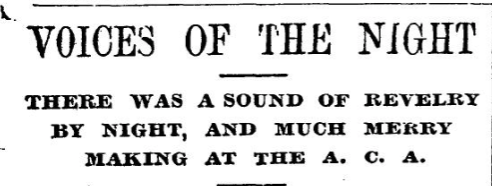
The ACA Camp By Night
It’s no wonder steamboats capitalized on offering excursions to view the ACA camp by night. What a sight it must have been! Lit by flickering lantern light, the tents themselves looked like large Chinese lanterns. Long strings of colorful Japanese lanterns were strung around the awnings of tents. Here and there, throughout the camp, campfires blazed.
In the evenings, there are various amusements, campfires being the favorite. On the first day of camp, an orchestra would be formed. Most often, this included guitars, violins, mandolins, and a cello. In 1893, two clubs brought pianos with them, and the orchestra included a trumpeter who floated just offshore and played several selections. The night air was filled with familiar and well-loved songs.
Sometimes, professional musicians were brought in by the Cataraqui Canoe Club of Kingston. In 1893, they transported the Kingston Battery Band to the camp for an evening of entertainment.
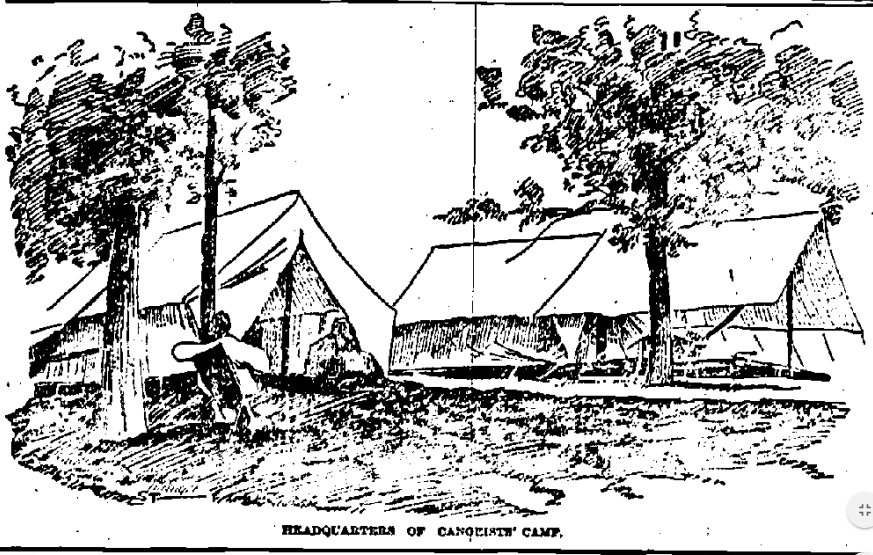
Besides musical sing-alongs, there were also recitations. As Daily on the St. Lawrence reported, “a Miss Aggie Scott of the Ottawa camp recited a charming little piece.” This was followed by “Miss Pauline Johnson, the Indian poetess, rendered three selections of Indian lore in a spirited manner.”
New York World gave more details concerning the Indian Princess. They claimed that Miss Pauline Johnston[2] was the most distinguished Canadian girl at the camp, a poetess of unusual ability and culture. “Her father was a Mohawk chief, her mother an Englishwoman. At the campfire of the Cataraqui Canoe Club of Kingston on Tuesday night, Miss Johnson appeared in full Indian costume and in the glare of red lights recited some of her own poems. She was most enthusiastically cheered.”
The evening by the campfire often ended with a trio of songs: “America,” “God Save the Queen,” and “Good Night, Ladies”, the lusty voices of the campers reverberating out over the tranquil waters of Eel Bay.
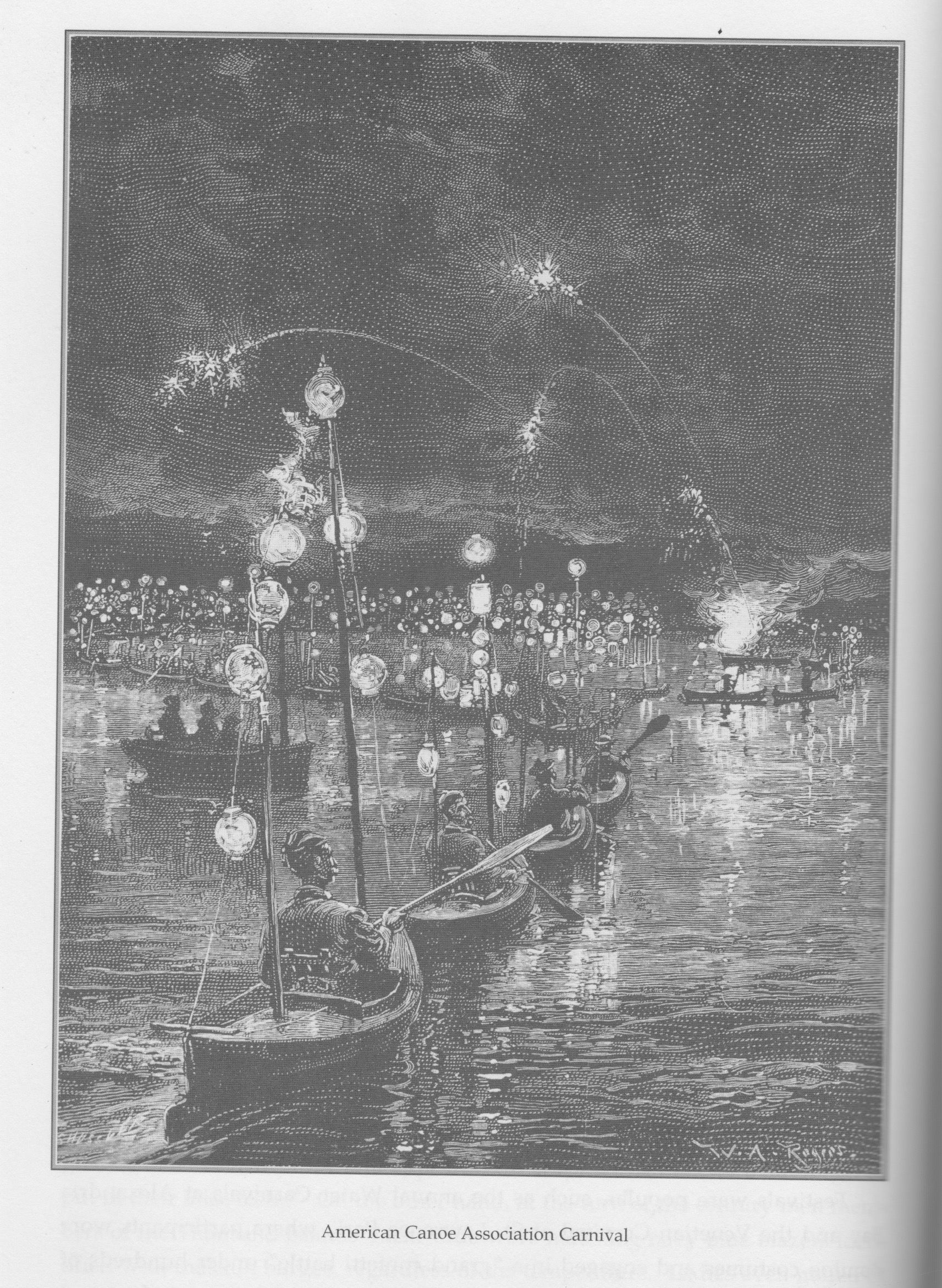
Venetian Parade
Perhaps the most spectacular nighttime event of the rendezvous was the Venetian parade, sometimes called the torchlight parade. This always occurred on a dark and still night. A hundred or more canoes decorated with paper lanterns moved mystically between dark water and dark sky. Their lights mirrored on the placid St. Lawrence. The canoes were decorated with Chinese lanterns in all sorts of fantastical shapes, hung from cords running between the masts. Colored fires were burned on plates resting on the deck of the canoe. Fireworks were set off from the canoes themselves. The whole fleet moved in a long, double file, two abreast.
ACA Camp Closes
I spend time almost every day unearthing descriptions of early island life, from an extensive newspaper archive. I’m thankful for the many newspaper correspondents who wrote with vigor and telling detail about the events of the day. I’ll close this piece with a quotation from Daily on the St. Lawrence, which describes the closing of the ACA camp in 1893:
“So camp life goes on, each day adding new pleasures and fresh enjoyments, and when at the close of the week, the merry party breaks up and the tents one by one are leveled to the ground it will be, not without a feeling of sadness, that those who have contributed so much to each other’s happiness say their parting farewells and see [the shores of Delaney point] fade from sight as all turn their faces homeward.”
Although written 128 years ago, those who summer in the islands can relate to those sentiments.
By Lynn E. McElfresh. Grenell Island
Lynn McElfresh delights us every single month . . . this month's article is just as wonderful as her first, written in August 2009. She has taken us on so many journeys into the past as well as introducing us to some amazing people, places and things! (See her first 110 articles here! To see the rest of Lynn’s island experiences, search our new TI Life format under Lynn McElfresh.)
Lynn came to Grenell Island for the first time in 1975, to meet her fiancé’s family, Lynn has written two novels in a series of nine novels about life in the Islands from 1883 to the 1960s. The third book, Grenell 1904, is almost here . . . and the fourth, Grenell 1912, is well underway!
See All About Lynn McElfresh & Her Books, written in the September 2020 issue of TI Life.
Editor's Notes:
*Times have changed since the late 19th century, when Squaw Point was named. According to Wikipedia: “The English word squaw is an ethnic and sexual slur, historically used for Indigenous North American women. Contemporary use of the term, especially by non-Natives, is considered offensive, derogatory, misogynist and racist." However, there are several islands and geographical points of land that still have that designation.
**Pauline Johnson (Tekahionwake). see The Canadian Encyclopedia for details. However, this editor never realized the famous Canadian had visited the Thousand Islands, a note to be remembered!
ACA Today
In 1903, after several years holding the ACA regattas on Grindstone Island in the US and also on Stave Island in Canada, C.E. Britton, a Gananoque businessman, purchased Sugar Island in the Canadian Lake Fleet for the Association. Members stored their equipment and canoes in a warehouse in Gananoque, and wrote in the spring to the superintendent so by the time they arrived for their summer regatta all their equipment was on the island and ready for use.
Today, Sugar Island is still the summer destination for ACA members. Generations of the same families return each summer, while others bought islands for themselves over the years. The Association has been fortunate to have strong leadership, which has fostered the sailing activities and preserved an island that can be used and enjoyed, for another century!
If you have photos from the Sugar Island years, share them with us, please. (info@thousandislandslife.com)
Photos of the Past
Our thanks to Dan Miller for sharing his ACA regatta photos. (Yes, our well known Dan Miller from ABM and the Cornwall Bros Store Museum in Alex Bay and don't forget his coffee business in Cape Vincent.)
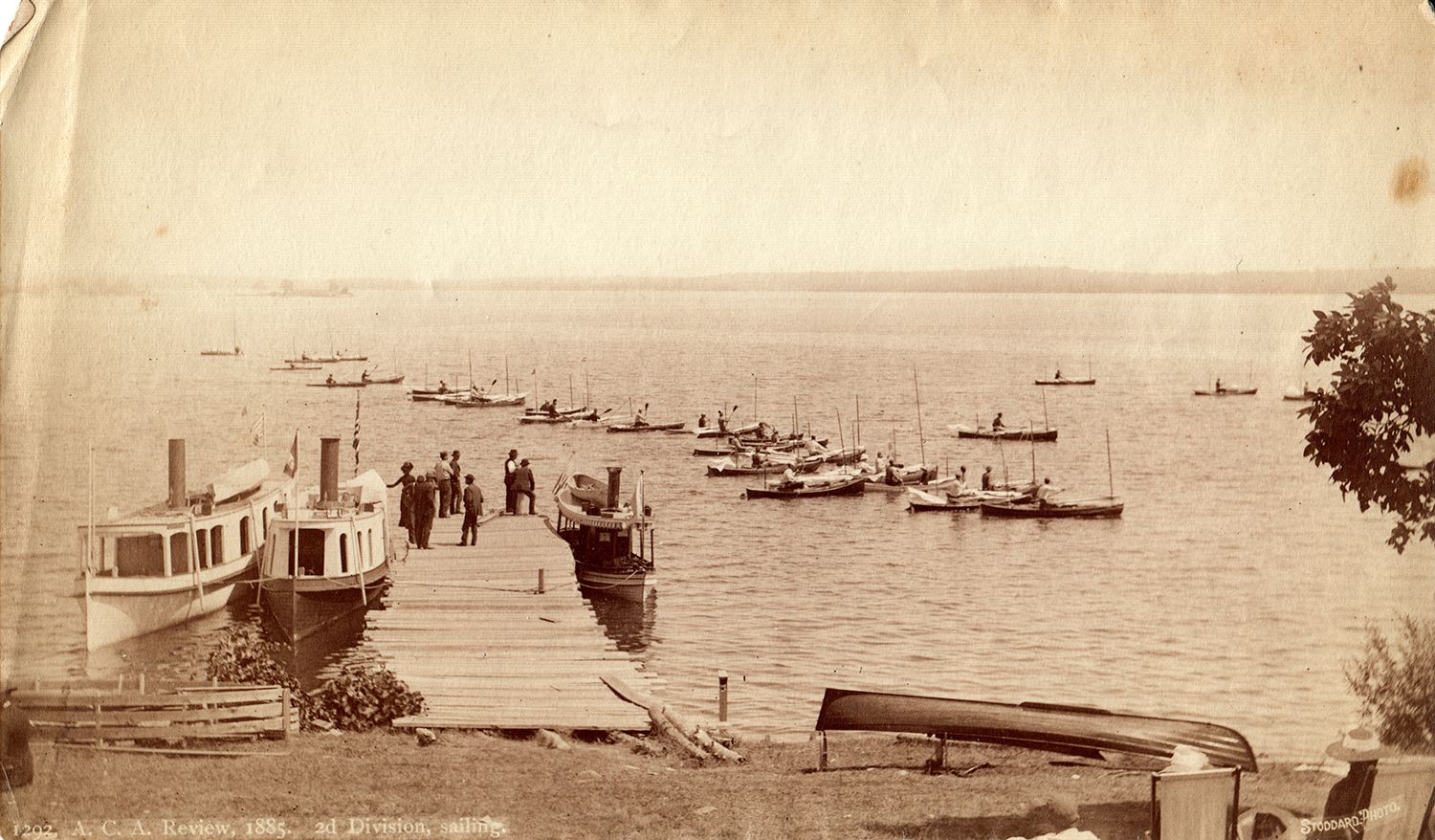
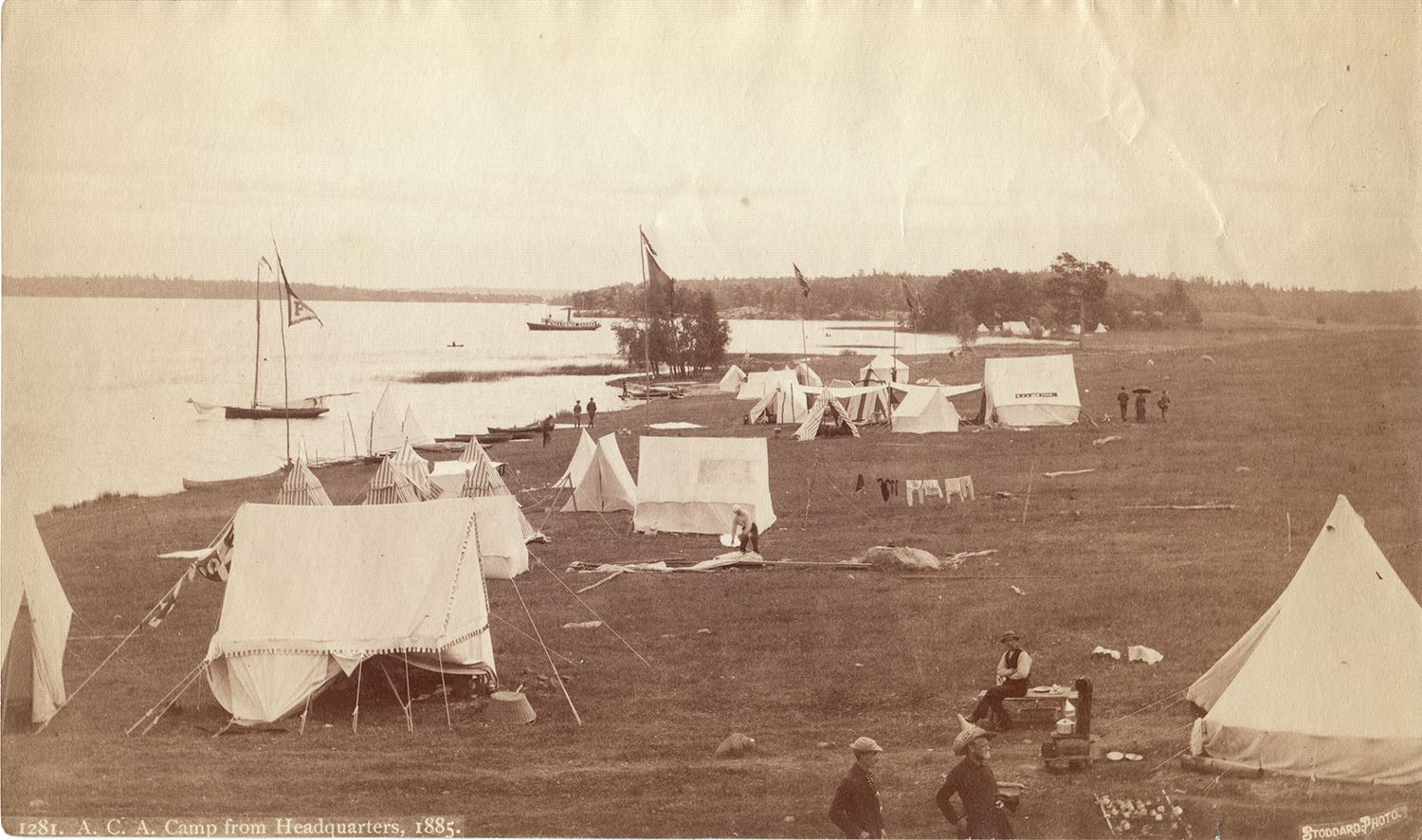
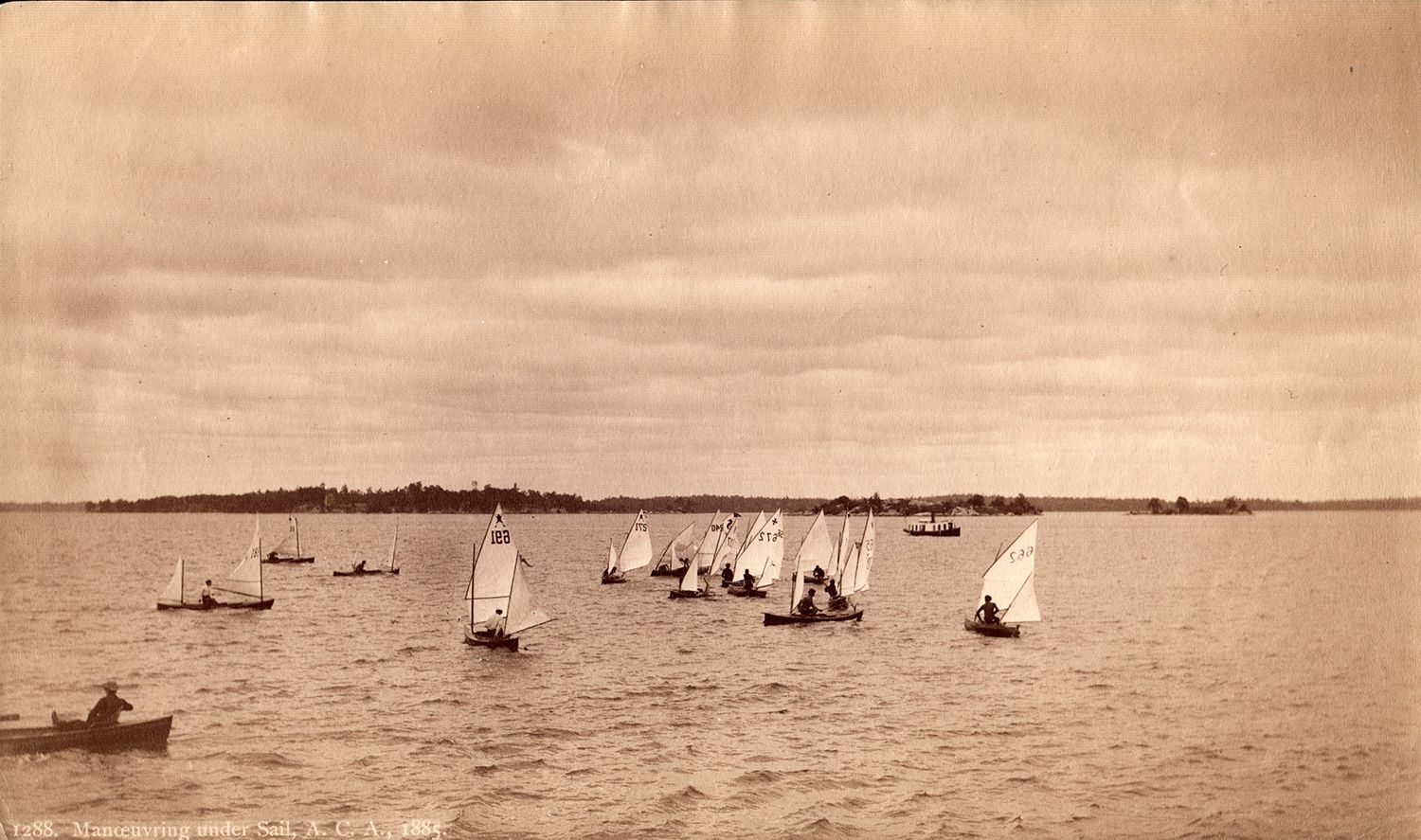
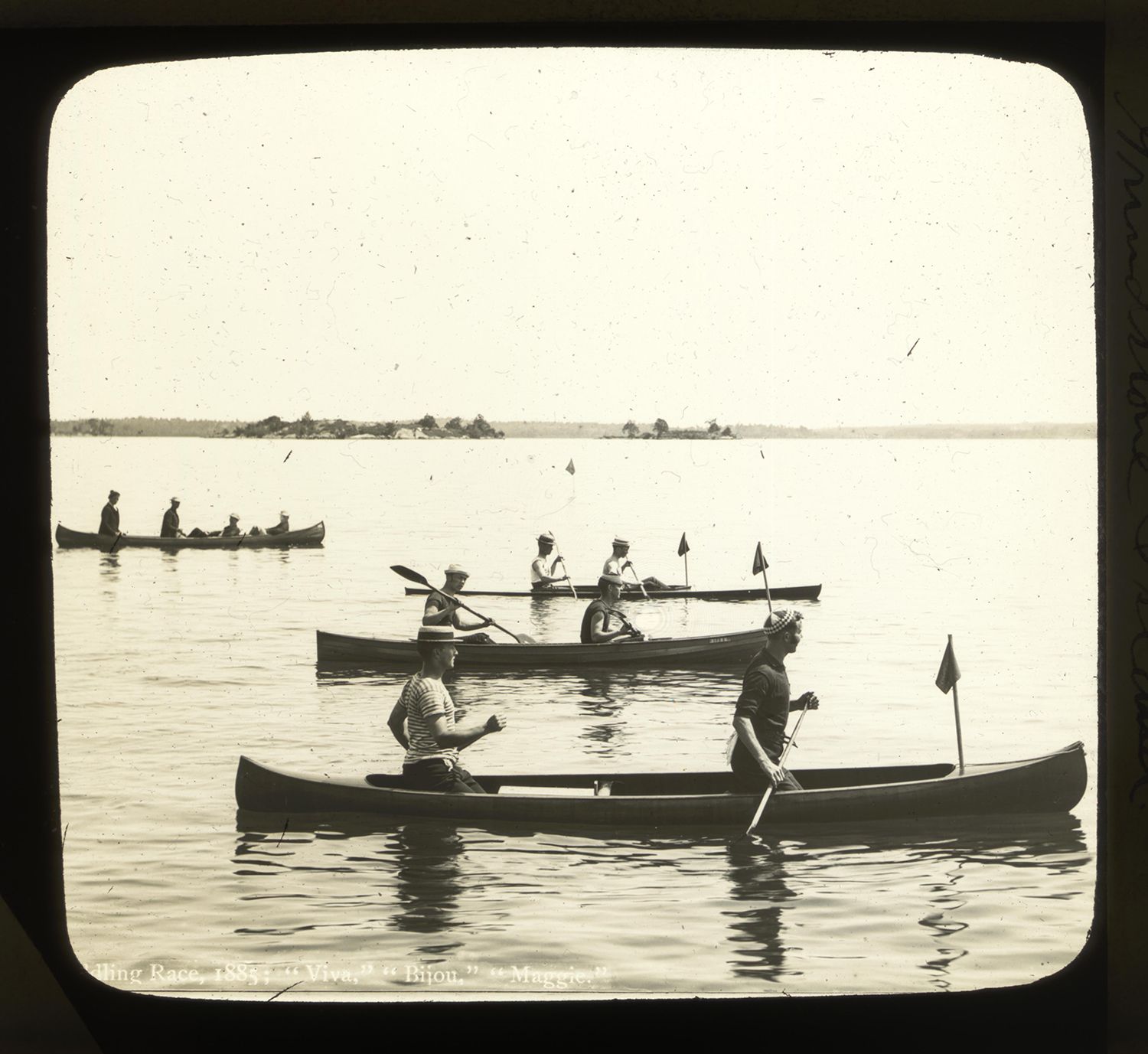
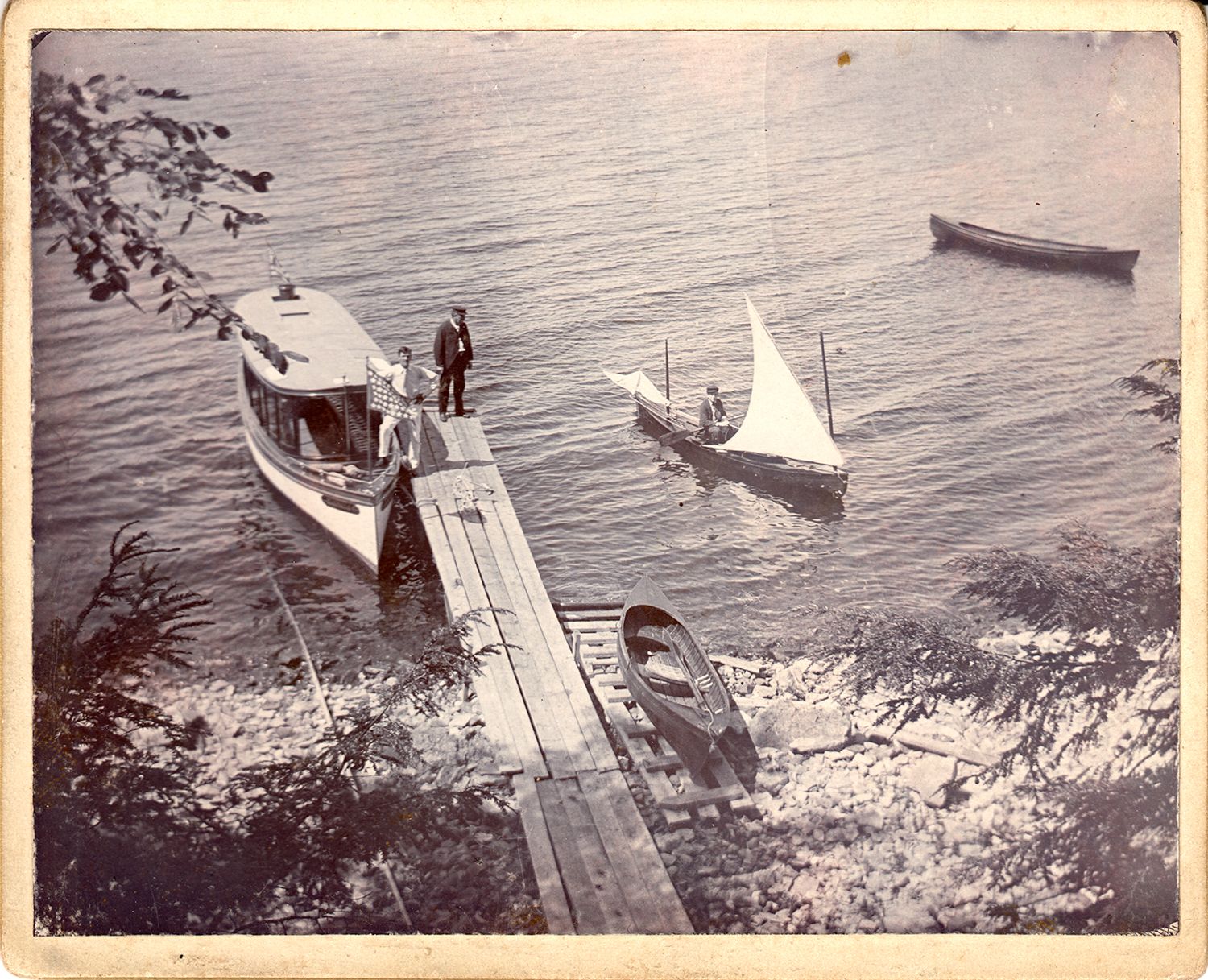
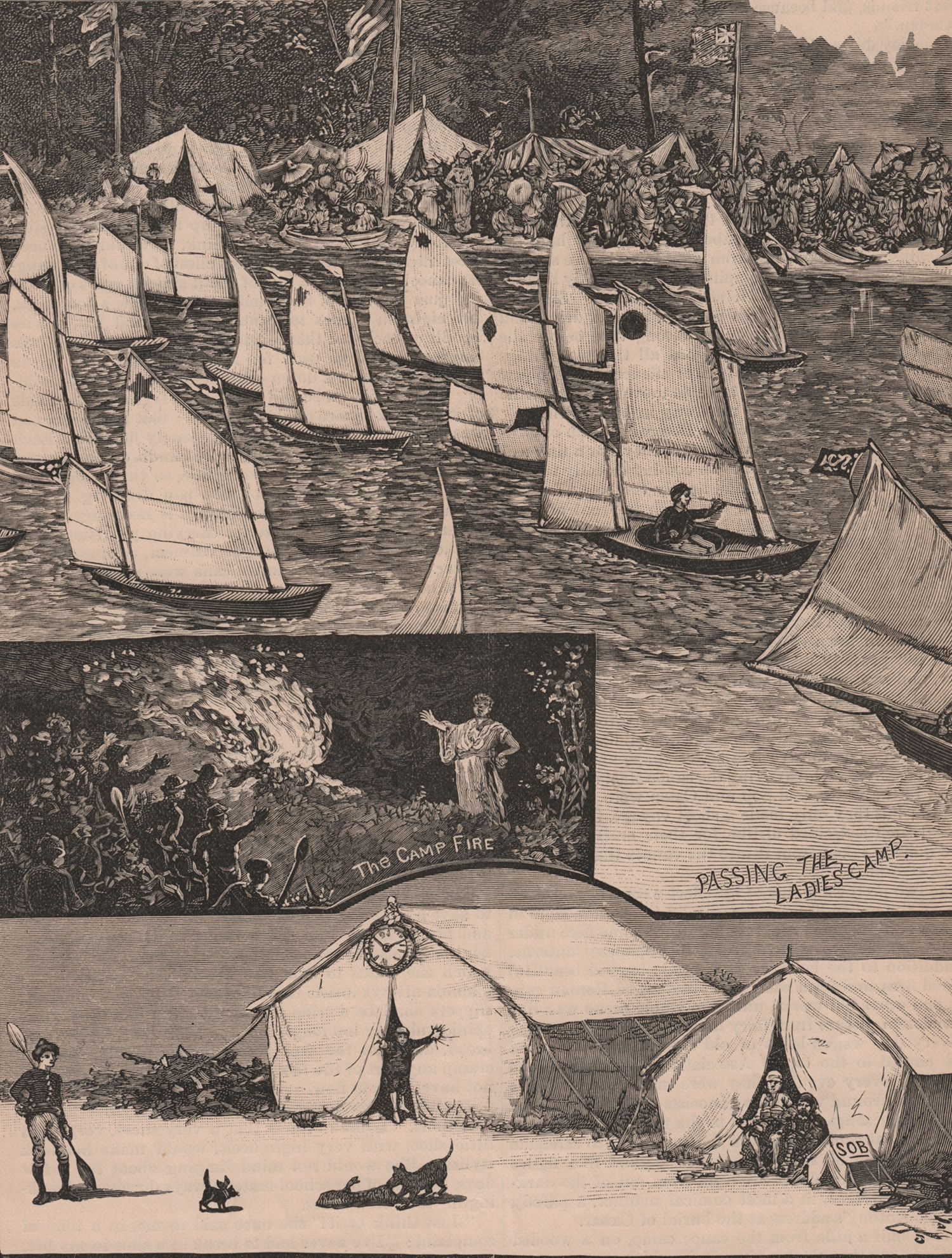


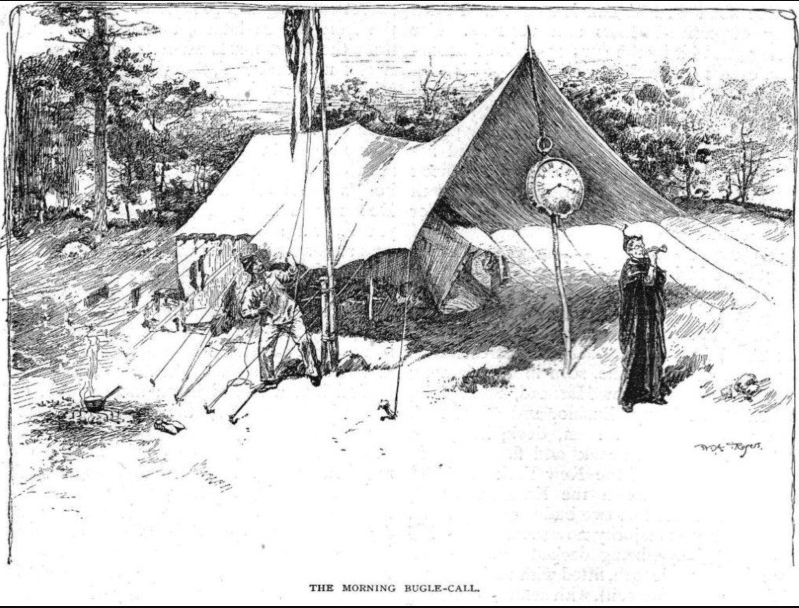



Please click here if you are unable to post your comment.